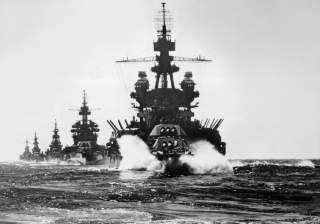The 5 Most Shocking Battleship Battles of All Time
Although eventually supplanted by the submarine and the aircraft carrier, the battleship took pride of place in the navies of the first half of the twentieth century.
On November 13, a task force including two Japanese battleships tried to “run the slot” and bombard Henderson. The IJN task force was met by a group of American cruisers and destroyers, which took advantage of surprise and good luck to cripple the battleship Hiei. American aircraft finished off Hiei the next day.
The following evening, the Japanese tried again. The Americans, virtually tapped out after months of grueling combat, went to their aces in the hole; USS Washington and USS South Dakota, a pair of fast battleships normally tasked with escorting carriers. Four destroyers screened the two battleships. The IJN force included the battleship Kirishima (sister of Hiei, and survivor of the first battle), four cruisers, and nine destroyers.
The early stages of the night action saw the IJN warships sweep aside the U.S. Navy destroyer screen. South Dakota and Washington became separated, and the former came under heavy fire from the entire Japanese task force, which caused high casualties and a complete loss of communications. When the Japanese opened up on South Dakota, however, they revealed their position to USS Washington, which took the opportunity to hammer HIJMS Kirishima with her 16” and 5” guns. Kirishima suffered mortal damage, fell out of the battle line, and eventually sank (although most of her crew was rescued). South Dakota and Washington escaped, the latter with virtually no damage.
Parting Salvos:
Only eight dreadnoughts remain, all in the United States. Over time, it is almost certain that this number will dwindle; several of the memorialized battleships are in poor condition, and likely will eventually find their way to the scrappers, or to service as an artificial reef. Nevertheless, for more than a generation analysts and the general public perceived these ships to constitute the currency of naval, and to some extent national, power.
This first appeared in 2015.

